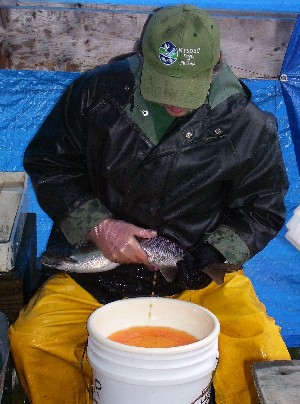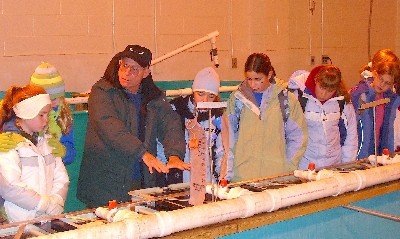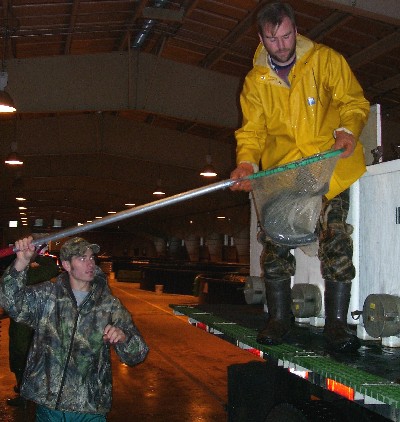The Adirondack Fish Culture Station |
New York State's primary Altlantic salmon hatchery |
 Hatchery Manager Ed Grant holds a salmon as he addresses Chazy High School students and their teacher regarding the egg take and fertilization process at Little Clear Pond |
|
Early November is a busy time of year for fish culturist Ed Grant and a devoted team of assistants working at the Adirondack Fish Hatchery in the tiny hamlet of Lake Clear near Upper Saranac Lake. Around the second week in November of each year New York State Fisheries Bureau employees focus their attention and skills on the collection of Atlantic salmon eggs and milt from protected brood stock residing in hatchery holding tanks and in nearby Little Clear Pond. The harvesting of eggs and their fertilization is the first step in the process of raising and stocking landlocked Atlantic salmon. The specialized fish rearing facility, officially known as the Adirondack Fish Culture Station, is one of twelve New York State hatcheries and is the only one solely devoted to raising the highly acrobatic breed of fish, scientifically known as Salmo salar or “salmon the leaper”.
|
 A hatchery employee gently strips a mature Atlantic salmon of her eggs |
|
During this late fall period, when female salmon become ripe for egg stripping, station employees net brood stock from the managed 360 acre pond and from large circular tanks within the facility to begin the life cycle for New York’s entire landlocked Atlantic salmon population. Workers record various data such as year class and size for each mature salmon and separate them by gender. By gently squeezing one fish after another they carefully extract eggs from the females and milt from the males and then mix the two in pans to replicate the fertilization process. The females are first anesthetized to aid in their handling, but males must be processed in all their energetic glory since their sperm could be rendered sterile by the sedative. After fertilization occurs iodine is added to the eggs to disinfect them. This year based on advice from the state’s fish health laboratory in Rome, New York, the egg disinfections period has been lengthened to assure containment of viruses like the one that has recently affected several species of fish in some of the Great Lakes and the St Lawrence River. The processed eggs are then carefully incubated in clean flowing water for approximately 70 days until small salmon known as sack fry emerge. Once the egg sack is absorbed the tiny salmon fry are moved to shallow flowing tanks and fed appropriately sized food until they are ready for stocking. Lake Champlain’s salmon fry get special treatment. Biologists believe the Champlain fry should grow from more natural food sources in the lake’s rivers so that they will be more likely to “imprint”, a term that refers to the returning of the salmon to its place of origin or stocking location. These fry are processed in colder water to initially slow their growth so that they begin to feed more heavily in May, just after being placed in the lake’s tributaries. The White River National Hatchery in Bethel, Vermont, operated by the US Fish and Wildlife Service, also obtains some eggs from the Adirondack hatchery for studies. Salmon from their studies will eventually be placed in Lake Champlain to supplement fish stocked by Vermont and New York State programs. Each year the Adirondack hatchery aids in the production and stocking of over 650,000 fish in more than 50 public waters throughout New York. Of the total salmon stocked by the Adirondack Fish Culture Station each year, about 325,000 are fry or newly hatched young. About 25,000 are fingerlings, 3 to 5 inches long, and approximately 300,000 are yearlings. |
 Trout Unlimited representative Bill Wellman shows touring students how water flows over incubation banks in the hatchery. |
|
Like many accessible North American coldwater lakes, Lake Champlain once had a healthy and plentiful population of Atlantic salmon. On a 1776 map of the lake a salmon fishery is noted at the mouth of the Great Chazy River. Historical records show fish up to 20 pounds were once caught there in abundance. By the late 19th Century most of the native North American Atlantic salmon stocks had disappeared, a result of over-fishing and the building of dams that blocked fish from reaching their traditional spawning grounds. Today sportsmen rely on hatcheries like the Adirondack Fish Culture Station to continually restock fish for recreational angling. Atlantic salmon are "anadromous", meaning they migrate from the ocean, or in the case of the landlocked variety, from the broad lake or pond, into freshwater tributaries. The spring migration begins in most waters during early to mid April, triggered by snowmelt and freshwater runoff. The imprinted salmon generally return to the freshwater feeder streams and rivers again beginning as early as September and continue into late November for the purpose of spawning. New York's predominant landlocked Atlantic salmon strain has been the Lake Clear strain. This strain was derived from three particular heritage strains, which include the Swedish Gull Spang strain as well as the West Grand Lake and Sebago Lake strains from the state of Maine. This year the Adirondack Fish Culture Station has increased its numbers of wild Sebago Lake salmon. Studies by both Vermont and New York agencies indicate that the Sebago Lake salmon is a better tributary spawning strain and will be more likely to imprint. The Adirondack Fish Culture Station also provides an educational resource for many students of all levels throughout the region. Each year the hatchery’s November assisted spawning event is witnessed by groups of elementary, middle school and high school aged students who tour the Fish Culture Station escorted by members of the Lake Champlain and Tri-Lakes Chapters of Trout Unlimited. These TU chapters sponsor “Salmon in the Classroom” science projects in a number of North Country schools. Along with teachers, they educate students about the life cycle of Atlantic salmon as well as the importance of water quality and a well-balanced environment. Each class is introduced to the breeding process at the hatchery and then they raise their own fish from eggs in aquariums in their classrooms throughout the winter. In spring the students stock their young fish in rivers and streams across the region. The experience builds stewardship skills and an appreciation for the aquatic environment. In addition to the salmon in the classroom projects and tours provided, the facility offers older high school and college-aged students an opportunity to volunteer for internships and job shadow programs. Students interested in environmental science careers like fisheries management work side by side with hatchery personnel to gather firsthand knowledge of the daily routine. By working briefly in their field of interest students are often reinvigorated to commit to the basic grind of school studies. The fish hatchery work and tours provide a positive balance of education and in-the-field interaction that is embraced by students of all ages. |
 Keene Valley Central High School student and job shadow intern, Jake Hooper, lifts a large salmon to another hatchery worker on a stocking truck |
| Back to the main page |